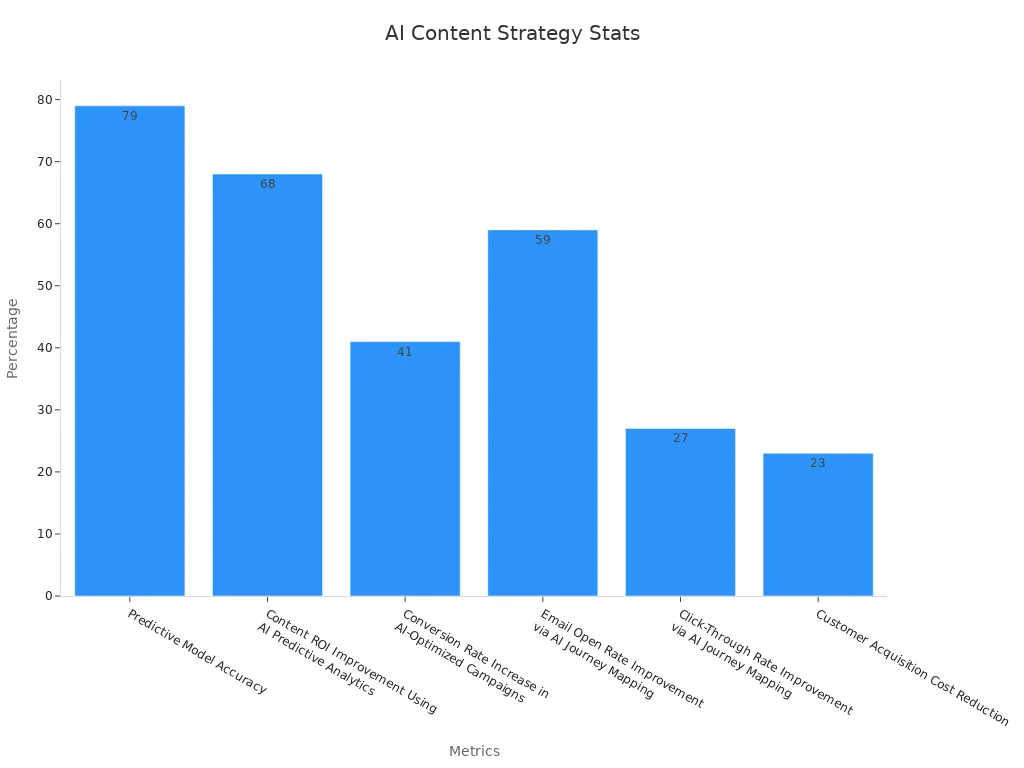Using AI to Align Content with Audience Segments

AI lets you align content with your audience in ways that old methods can’t match. Traditional segmentation often relies on static demographics, so it misses the unique preferences and behaviors that make your audience tick. With AI, you can tap into data-driven insights that uncover hidden customer segments and predict what people want next. For example, a travel site that used AI-powered chatbots saw booking conversions jump by up to 25%. Marketers now report up to 15 times more actionable customer segments and a 38% boost in engagement rates. The move to AI means you can react in real time and deliver what your audience actually wants.
Statistic Description | Value |
|---|---|
Marketers using AI for audience segmentation | |
Increase in actionable customer segments | Up to 15 times |
Improvement in engagement rates from AI | 38% higher |
Key Takeaways
AI helps marketers find detailed audience groups by analyzing lots of data, making messages more personal and relevant.
AI works in real time to spot changes in customer behavior, so you can send the right content at the right moment.
Using AI lets you personalize content for many people at once, which boosts engagement, loyalty, and sales.
Following clear steps like setting goals, gathering data, choosing tools, and building segments helps you use AI effectively.
Protecting customer privacy and keeping your brand authentic are important when using AI to build trust and long-term success.
AI Audience Segmentation

Traditional vs. AI Segmentation
You might remember when marketers grouped people by age, gender, or where they lived. That’s traditional segmentation. It uses simple rules and often misses what makes each person unique. These old methods can’t keep up with how fast people change their minds or try new things.
Let’s look at how AI changes the game:
Traditional Segmentation | AI-Driven Segmentation | |
|---|---|---|
Methodology | Manual, rule-based, KPI-driven (e.g., SQL, K-means) | Advanced algorithms, adaptive learning, deep learning |
Data Handling | Limited to simpler, low-dimensional data | Handles complex, high-dimensional, and diverse data |
Segment Quality | Broad, one-dimensional, less precise | Highly granular, precise, unbiased |
Adaptability | Less adaptable, needs engineer intervention | Dynamic, adapts to changing data and market conditions |
Business Suitability | Good for small, simple businesses | Best for medium to large businesses with complex data |
Outcome Focus | Basic segmentation, limited business impact | Outcome-driven, improves business profit and insights |
AI-driven segmentation uses smart algorithms to look at huge amounts of data. It finds patterns and groups you might never spot on your own. AI can even spot tiny groups—called micro-segments—that want something special. This means you can talk to each group in a way that feels personal.
Tip: AI segmentation helps you keep up with your audience as they change, so your messages always feel fresh.
Real-Time Grouping
With AI, you don’t have to wait for monthly reports or guess what your audience wants. AI tools work in real time. They watch what people do—like what they click, buy, or share—and update your audience groups right away.
AI processes data as it comes in, so you can react fast.
You can spot new trends or shifts in customer behavior as they happen.
Real-time grouping lets you send the right message at the perfect moment.
For example, if a group of shoppers suddenly starts looking at winter jackets, AI will notice and help you target them with jacket deals right away. This quick response keeps your marketing sharp and your audience engaged.
AI Content Alignment Benefits
Personalization at Scale
AI helps you personalize content for thousands—even millions—of people at once. You don’t have to guess what your audience wants. AI looks at huge amounts of data and finds out what each person likes, clicks, or buys. This means you can align content with every segment, making each message feel special.
Check out these numbers:
Consumer Behavior Metric | Percentage / Figure |
|---|---|
Consumers losing loyalty without personalization | 62% |
Customers reporting increased brand satisfaction due to personalization | 52% |
Consumers more likely to purchase from brands that personalize | 76% |
When you use AI to personalize at scale, you boost engagement and loyalty. Most people expect brands to know what they want. If you don’t deliver, they might leave for someone who does.
Tip: Personalization isn’t just a nice touch—it’s what your audience expects.
Predictive Insights
AI doesn’t just look at what happened yesterday. It predicts what your audience will want tomorrow. You can use these insights to plan smarter campaigns and create content that hits the mark.
Metric Description | Statistic Value | Source/Year |
|---|---|---|
Predictive Model Accuracy | 79% (up from 52% in 2019) | MIT Technology Review, 2023 |
Content ROI Improvement Using AI Predictive Analytics | 68% higher ROI | Forrester, 2023 |
Conversion Rate Increase in AI-Optimized Campaigns | 41% higher conversion rate | HubSpot Research, 2023 |
Email Open Rate Improvement via AI Journey Mapping | 59% higher open rates | Epsilon Marketing, 2023 |
Click-Through Rate Improvement via AI Journey Mapping | 27% higher click-through rates | Epsilon Marketing, 2023 |
Customer Acquisition Cost Reduction | 23% lower cost | Boston Consulting Group, 2022 |

With AI, you can spot trends before they happen. You get to align content with what your audience will want next, not just what they wanted last week.
Automated Content Delivery
AI takes care of the heavy lifting. It automates content discovery, tagging, and distribution across all your channels. You save time and reach your audience faster. AI can even adjust content for different languages and devices, making sure everyone gets the best experience.
AI-powered platforms track how your content performs in real time. They help you see what works and what needs to change. You spend less time on manual tasks and more time creating great content. Companies using AI have cut daily monitoring from hours to minutes and boosted sales productivity by over 14%. That’s real efficiency.
Note: Automation lets you scale your marketing without losing the personal touch.
Steps to Align Content with AI

Define Goals
Start by deciding what you want to achieve. Do you want more leads, higher sales, or better customer loyalty? Clear goals help you choose the right AI tools and measure your progress. For example, if you want to boost brand awareness, you might focus on AI tools that help with content creation and social sharing. If you want more sales, look for AI that helps with lead generation and conversion.
Tip: Write down your goals and share them with your team. This keeps everyone focused and makes it easier to track results.
Gather and Integrate Data
AI works best when it has lots of good data. Collect information from your website, social media, email, and sales. Bring all this data together in one place. This helps AI spot patterns and build better audience segments.
Use tools that connect with your current systems.
Make sure your data is clean and up to date.
Check for missing or duplicate information.
A company once used AI to study customer habits and found groups like eco-friendly shoppers and bargain hunters. By knowing these groups, they could align content and offers to match each group’s needs. This led to more sales and happier customers.
Choose AI Tools
Pick AI tools that fit your goals and work well with your team. Here’s a quick checklist to help you decide:
Match tool features to your goals, like lead generation or brand awareness.
Make sure the tool connects with your current marketing systems.
Look for tools that are easy to use.
Check if the tool can grow with your business.
Make sure it keeps your data safe and private.
See what kind of support and training the vendor offers.
Compare costs and expected benefits.
Try out the tool before you commit.
Some popular tools include Popsy for finding leads on Reddit, HubSpot for all-in-one marketing, and Jasper AI for fast content creation. Each tool has its strengths, so think about what matters most for your business.
Note: Always test new tools with a small project first. This helps you see if they really help you align content with your audience.
Build Segments
Now it’s time to let AI do its magic. Use your chosen tool to group your audience based on their actions, interests, and needs. AI can find patterns you might miss, like people who shop during certain seasons or those who care about eco-friendly products.
Update your segments often as new data comes in.
Combine AI insights with your own knowledge of your customers.
Don’t be afraid to create small, focused groups for special campaigns.
Starbucks used AI to predict what customers wanted based on things like weather and past orders. This helped them send the right offers at the right time, boosting loyalty and sales.
Personalize Content
With your segments ready, you can now align content to each group. AI helps you create emails, ads, and web pages that speak directly to what each segment cares about. You can show eco-friendly buyers green products or send special deals to price-sensitive shoppers.
KPI Name | What It Measures | Why It Matters |
|---|---|---|
Sales increase from personalized content | Shows if your strategy works | |
Customer Satisfaction | How happy your customers are | Keeps people coming back |
User Retention Rate | How many users stay with your brand | Measures long-term engagement |
Marketing ROI | Profit from your AI-driven campaigns | Proves the value of your investment |
AI lets you personalize at every step, from emails to website content. This makes your audience feel seen and valued.
Automate and Optimize
Let AI handle the busy work. Set up your tools to send content automatically based on what your audience does. Track how each piece of content performs. Use AI to spot what works and what doesn’t.
Watch key metrics like click-through rates, time on page, and conversion rates.
Test new ideas and let AI help you find the best approach.
Keep your data fresh and update your segments often.
Pro Tip: Mix AI insights with your own creativity. AI can show you what’s working, but your human touch makes the content shine.
By following these steps, you can align content with your audience in a way that feels personal and timely. Keep testing, learning, and improving. That’s how you stay ahead.
Use Cases and Challenges
E-Commerce
You see AI everywhere in e-commerce. It helps you spot what your customers want and when they want it. AI tools group shoppers by how they browse, what they buy, and even how often they visit your site. This means you can send the right offer at the perfect time. For example, automated RFM segmentation lets you find your best customers and those who might leave soon. You can then create special deals just for them.
Here are some key ways AI boosts your e-commerce results:
Tracks customer journeys and sends timely nudges to increase sales.
Updates segments in real time so your campaigns stay fresh.
Uses behavioral data to make every message more relevant.
Metric | Explanation |
|---|---|
Personalized campaigns boost how much customers interact with your brand. | |
Improved Conversion Rates | Targeted content and timing help more shoppers decide to buy. |
Higher Open Rates for Emails | Segmented emails get more attention and clicks. |
Enhanced Customer Lifetime Value | AI finds upsell and cross-sell chances, so customers spend more over time. |
Reduced Churn Rates | Predictive analytics help you keep customers before they leave. |
Improved ROI | Smarter targeting means you get more from every marketing dollar. |
B2B Marketing
AI changes how you reach business customers, too. You can move from broad messages to focused campaigns for each account. Account-Based Marketing (ABM) uses AI to pick out key companies and send them custom content. This approach helps you connect with decision-makers and close more deals.
Some ways AI helps in B2B marketing:
Groups leads by their online actions, so you know who is most interested.
Builds lookalike audiences to find new prospects like your best clients.
Ranks leads by how likely they are to buy, saving you time.
Tracks engagement on platforms like LinkedIn and recommends who to contact next.
Uses chatbots to gather info and refine your segments in real time.
You get smarter campaigns and better results because you focus on what matters most to each business.
Data Privacy
AI needs lots of data to work well, but you must protect your customers’ privacy. Data security is a big challenge. You have to keep personal information safe and follow all privacy laws. If you don’t, you risk losing trust and facing legal trouble.
Tips for handling data privacy:
Use secure systems to store and process data.
Only collect what you need for your campaigns.
Be clear with customers about how you use their data.
Regularly check your systems for any weak spots.
AI can help by spotting risks and alerting you to problems, but you still need to stay careful.
Authenticity
People want real stories, not just polished ads. When you use AI to create content, you need to keep your brand’s voice and values. Most consumers say trust is the top reason they buy from a brand. Over 75% worry about fake or misleading content from AI.
Evidence Type | Description |
|---|---|
Statistical Evidence | 81% of consumers say trust is the deciding factor in purchasing; over 75% concerned about AI misinformation. |
Consumer Sentiment Data | 73-80% of consumers view misinformation negatively and distrust brands linked to it. |
Business Outcome | Authentic content leads to higher engagement, trust, ROI, and long-term customer loyalty. |
You can use AI to find and share real customer stories or highlight behind-the-scenes moments. User-generated content builds trust and feels more genuine. Don’t let AI take over your brand’s personality. Use it to support your message, not replace it. Keep checking your content for accuracy and listen to feedback. Authenticity brings better results and keeps your audience coming back.
AI helps you align content with your audience faster and smarter. Companies like Starbucks and Netflix saw big wins—higher customer satisfaction, more sales, and better productivity—by using AI-driven tools. You can start by checking your current audience segments and trying out simple AI tools.
Ready to boost your results? Take the first step and let AI help you connect with every customer in a way that feels personal.
Review your segments
Explore AI-powered platforms
Watch your engagement grow 🚀
FAQ
How does AI know which content fits each audience segment?
AI looks at data like clicks, purchases, and time spent on pages. It finds patterns in what people like. Then, it matches content to each group. You get smarter suggestions for every segment.
AI learns from your audience’s actions. The more data you have, the better it works!
Can I use AI tools if I have a small business?
Yes, you can! Many AI tools work for small businesses. You do not need a big budget. Start with simple tools that help you group your audience and send personalized messages.
Try free trials first.
Pick tools that fit your needs.
Will AI replace my creative work?
No, AI helps you, but it does not replace your ideas. You still create the main message and style. AI gives you suggestions and saves time. You add the human touch that makes your brand special.
Is my customer data safe with AI?
Most AI tools use strong security to protect your data. You should always check privacy settings and follow rules. Tell your customers how you use their data. Trust builds strong relationships.
Tip: Use tools with good reviews and clear privacy policies.
See Also
Customizing Startup Blog Posts To Engage Target Readers
Writesonic AI And QuickCreator Battle For Content Supremacy
Transforming Blogging With AI Tools That Redefine Content Creation
Strategies For Content Analysis To Surpass Your Competition
Complete Guide To Achieving SEO Excellence Using Perplexity AI

